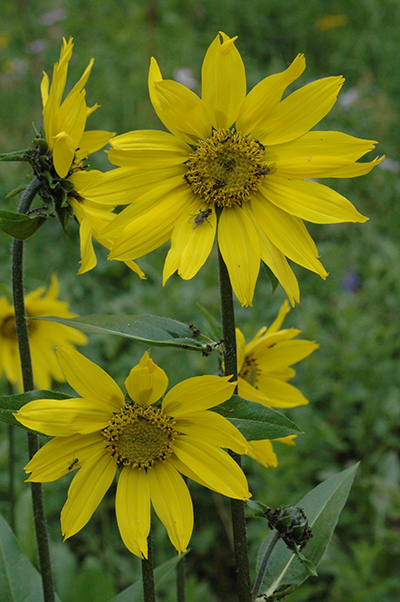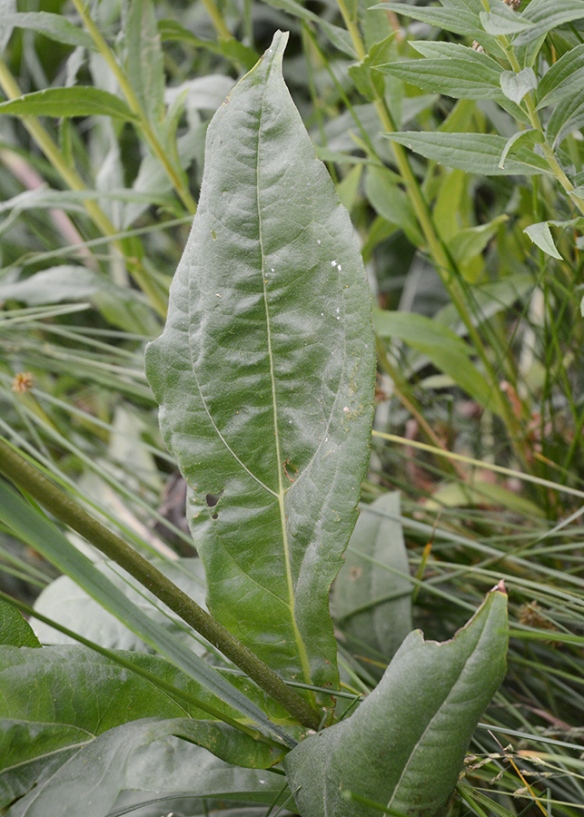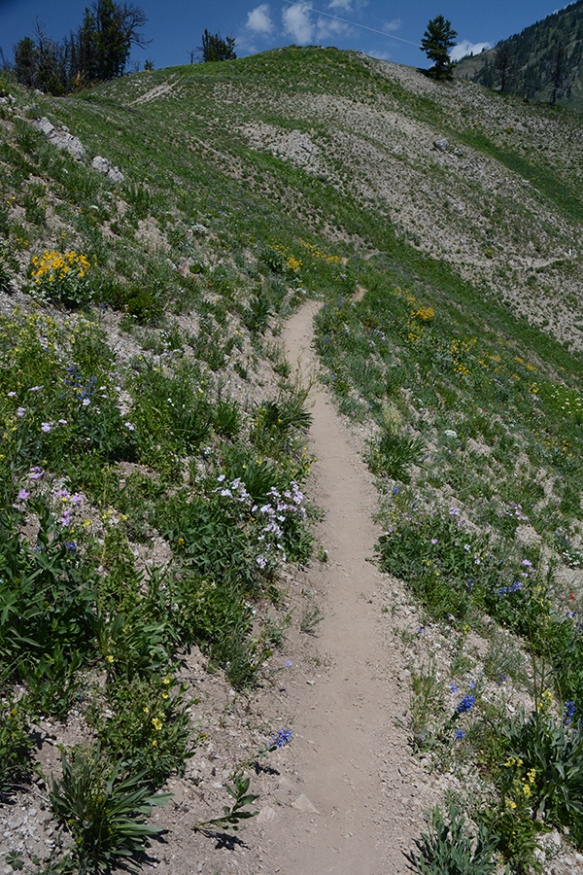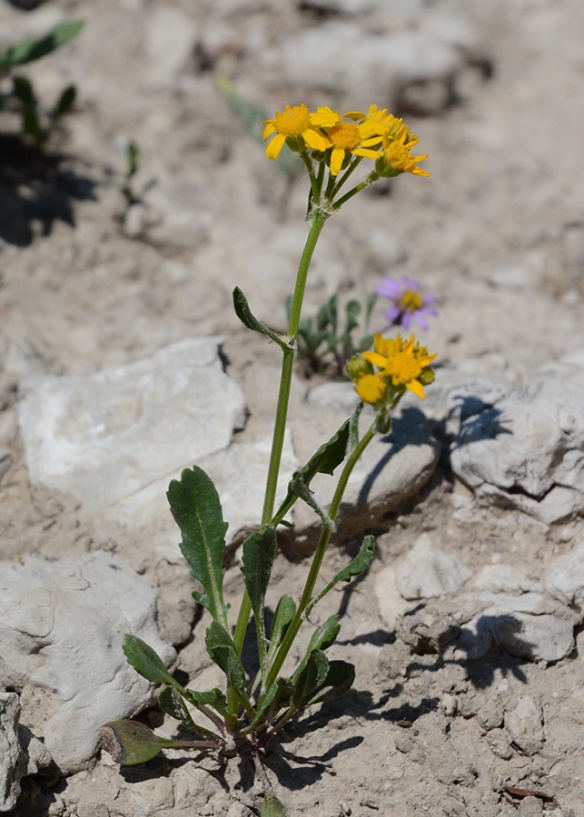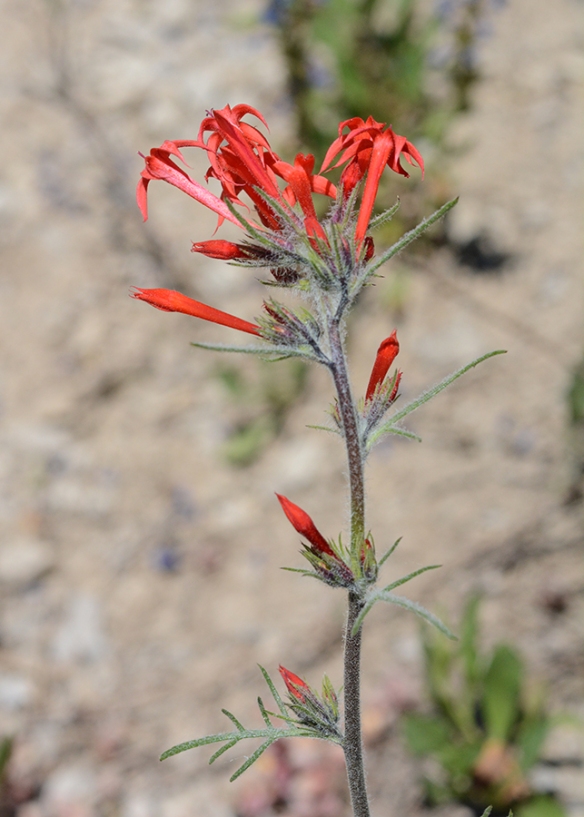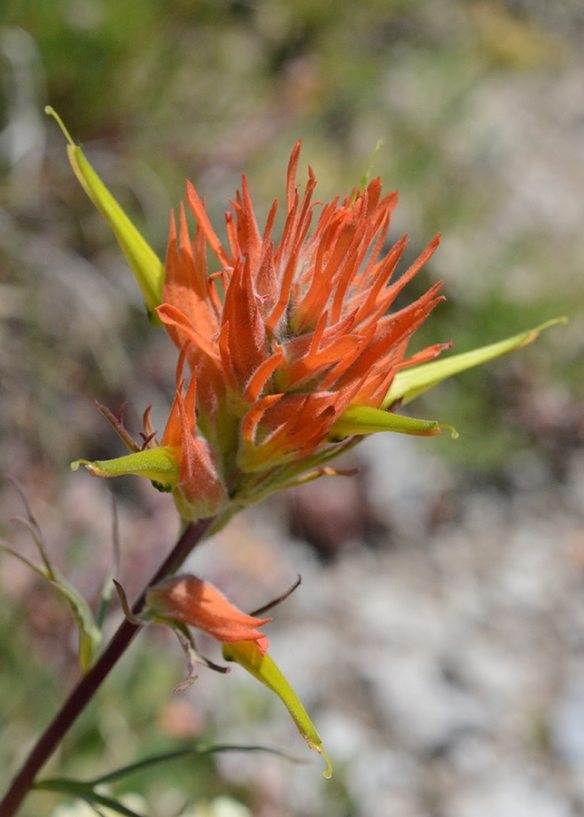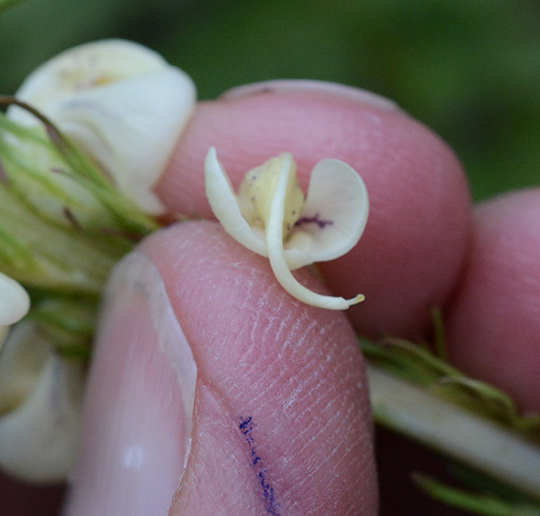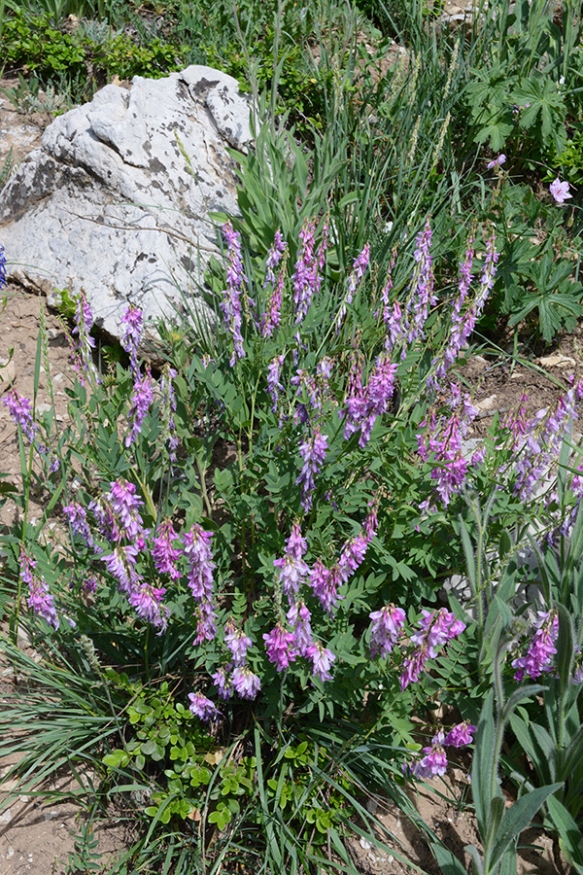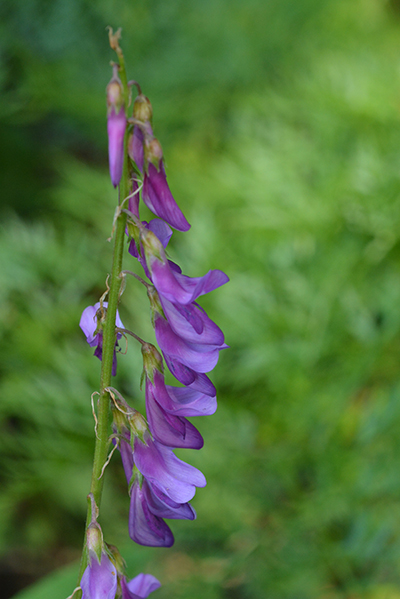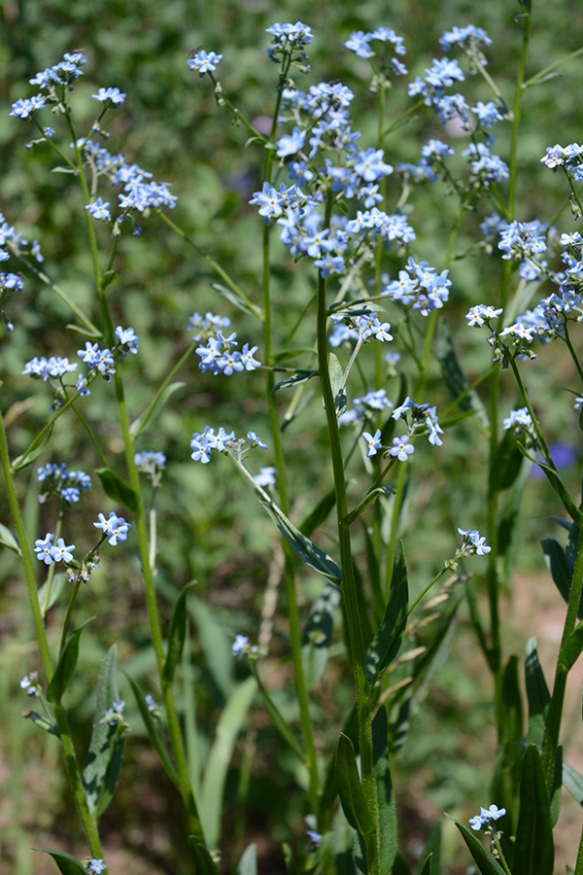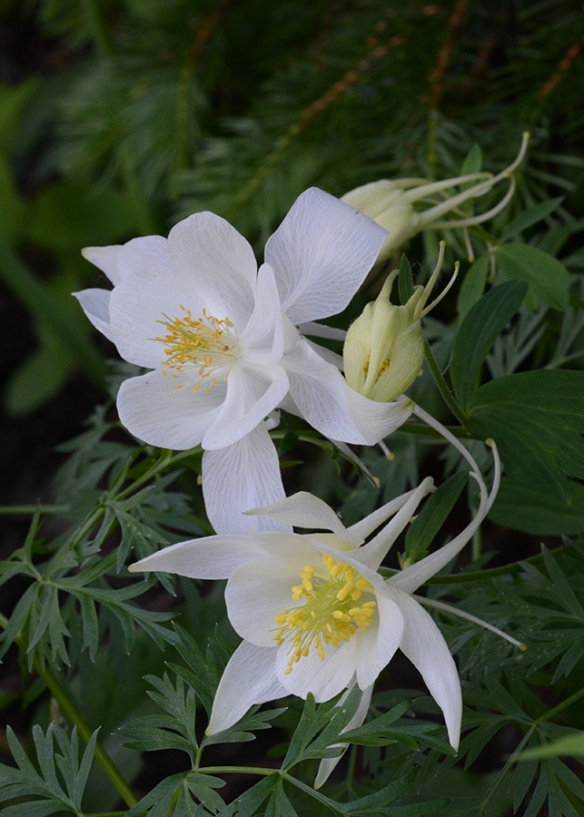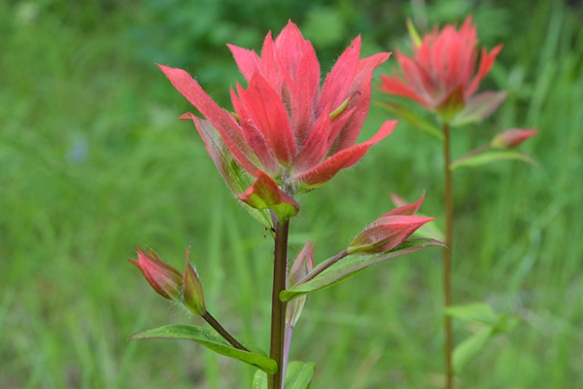
Moose-Wilson Road has an array of tall forbs (wildflowers) – Tall Larkspur, Butterweed Groundsel, and Canada Goldenrod.
As one drives along the Moose-Wilson Road or up to Two Ocean Lake, or hikes through montane meadows, several tall 3-6’ wildflower species may divert your attention. Most of these thrive in relatively moist and/or cool situations where they can take up sufficient moisture to support their large bodies of stems and leaves, along with plentiful, showy flowers.

Giant Hyssop – Agastache urticifolia – is a member of the Mint Family. Feel the square stem, smell the fragrant leaves, and observe what comes to the “irregular” flowers. Occasionally it is pollinated by hummingbirds, probably attracted by the reddish pink bracts. The stamens protrude beyond the fused petals, bonking pollen on the heads of pollinators.
Pause and take a close look and think about what is happening: What do the flowers look like: are they simple or complicated; all they all the same color or highly variable; what are their pollinators? Unseen variations may be that some species are extremely poisonous. Other species display an extraordinary abundance of flowers this year due to unusual environmental triggers last year. Many factors: environmental and biological–affect what grows where in Teton County and well beyond. Below are a few species to ponder.
Tall Larkspur – Delphinium occidentale – Many have noticed the 4-6’ tall, deep blue, pale blue, to white spires along the Moose-Wilson Road and meadows of Two-Ocean Lake and near Goodwin Lake Trail. The reason for the three color variations of our Grand Teton populations was studied by Ron Scogin in 1993. While he didn’t come to any direct conclusions, the researcher found that all plants had similar number of flower stalks (inflorescences) although the albino stalks had many fewer flowers/stem. All had similar seed results per flower indicating that the pollinators–bees and hummingbirds–visited them without discrimination. Furthermore, over time, the proportion of each color morph has remained pretty much the same. The proportion was likely dependent on the original number of seeds per morph and are result of the “founder effect”. So far the colors remain separate and in the same approximate proportions. A follow up study, with new genetic understanding, would be interesting. For more details on the work 20 years ago: http://repository.uwyo.edu/cgi/viewcontent.cgi?article=1792&context=uwnpsrc_reports
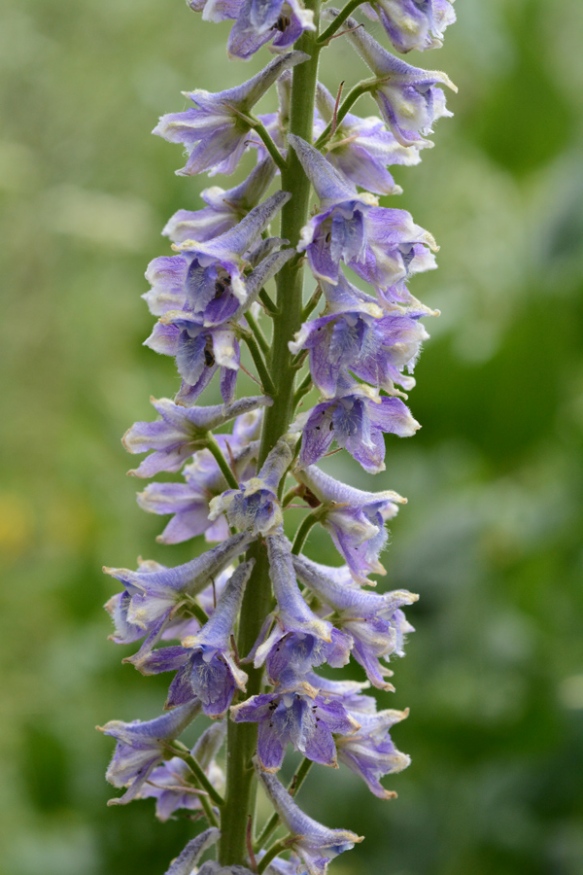
Tall Larkspur – Delphinium occidentale – has trumpet shaped flowers that require pollinators to push deeply into them to receive their rewards. (And an esoteric taxonomic note: According to the expert Holmgrens, we have only D. occidentale, not D. glaucum here in Wyoming. It comes down to hairy, not smooth, follicles or fruits.)
Monkshood – Aconitum columbianum –The genus name Aconitum comes from the Greek akoniton: Theophrastis used this name to indicate “poisonous plant”, which indeed it is!
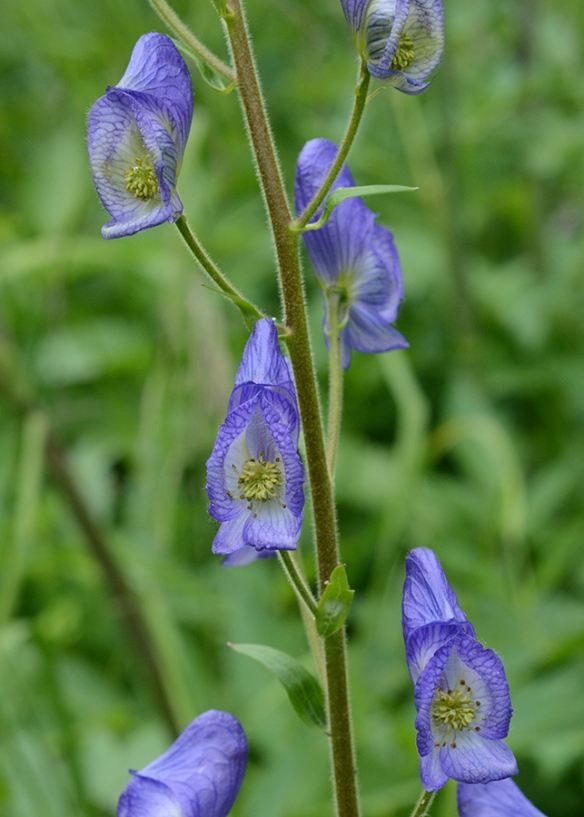
Monkshood – Aconitum columbianum – is related to the similar looking Tall Larkspur (see above). both are in the highly variable Buttercup Family and have complicated flowers. It is also deadly poisonous.
Monkshood is pollinated by both queen and worker bumblebees, as well as moths and hummingbirds. Observe the structure of the flower. The five sepals (not petals) form a complex purple flower.

Monkshood sports a “hood” that covers two petals and nectaries. Four additional sepals: two side, two bottom, surround the many anthers and three stigmas. All parts of the plant are poisonous. Found in wet meadows.
The two lower and two side sepals encase and then expose the numerous anthers, while the hood covers two greatly altered petals which contain a stiff coiled spur terminating with nectar glands. Observe when the anthers open and release their pollen (then fade), and when the 3 hidden stigmas become available amidst the anthers: the timing of the male and female reproductive parts is separate to facilitate out-crossing.
Sharp-tooth Angelica – Angelica arguta – A member of the Parsley Family – as one can tell by the umbrella arrangement of their tiny flowers, this plant typically grows to 4-5’ in moist montane situations.
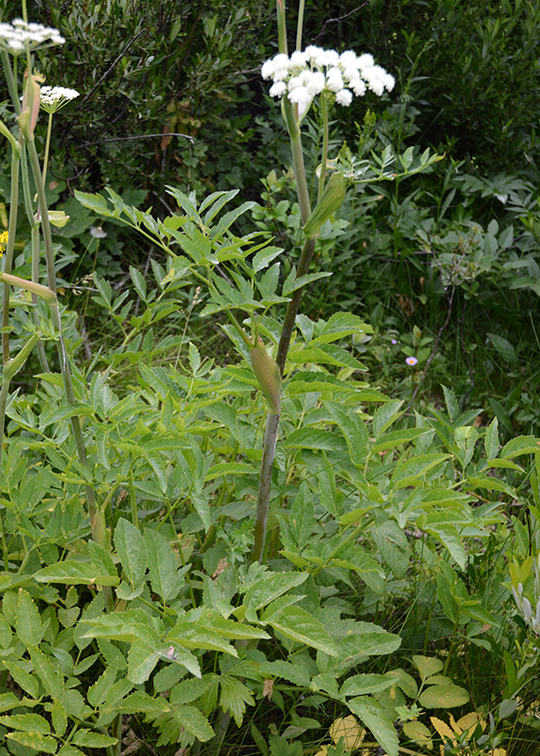
Sharp-tooth Angelica – Angelica arguta – is in the Parsley Family, same as Cow Parsnip (see below). But Angelica has more divided leaves and has a smooth, not hairy, stem.
Sharp-tooth Angelica can be mistaken for the more robust Cow Parsnip, but notice the large, toothed leaves are divided into numerous, smaller leaflets. The stem is smooth and slightly bluish. Angelicas have been used for medicines by many indigenous people, but note the species also resembles Water Hemlock – Cicuta maculata – called “suicide plant” by the Iroquois – which also grows in moist to wet sites! Always make sure you know the ID of any plant you use!

Water Hemlock – Cicuta maculata – grows in similar wet places and can be mistaken for Angelica. The Iroquois called this plant “suicide plant” for a reason. Here it is in a ditch in Wilson.

Water Hemlock – Cicuta maculata – looks very similar to Angelica, but it is not an angel! It is deadly poison. Note the side veins end at the indentations of the teeth of the leaf. Know your plants well before you touch or eat them!
Cow Parsnip – Heracleum spondylium – One of the largest and most obvious members of the Parsley Family, this giant is found in wet meadows. The inflorescence is the size of a dinner plate. The stems are very hairy (hairs may cause a rash) and the giant leaves are divided into three large, jagged lobed leaflets. Many pollinators take advantage of the numerous tiny flowers.
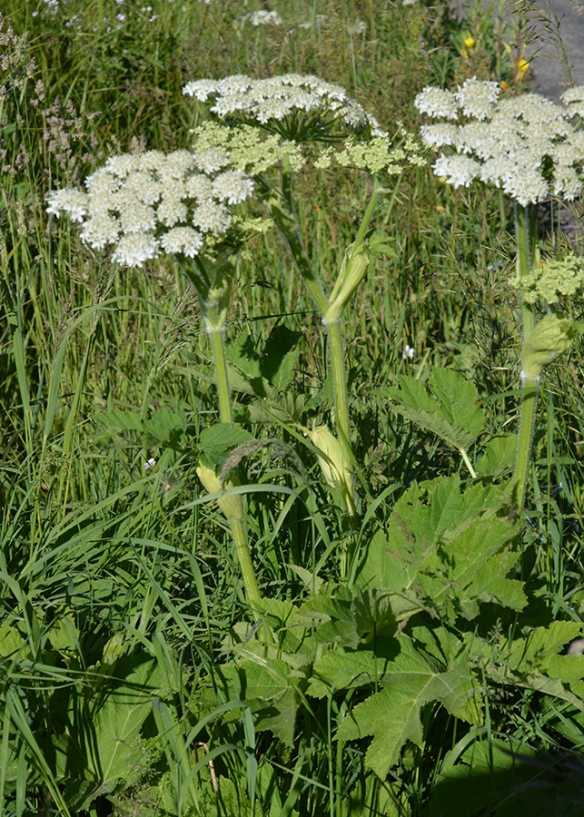
Cow Parsnip – Heracleum spondylium – has large jagged leaves, plate-sized flower clusters, and very hairy stems. The hairs can cause a rash in some people.
Butterweed Groundsel – Senecio serra – This tall, 4-5’ yellow composite plant is frequent in moist to wet meadows. The leaves are 4-5”, oblong to lance-shaped, with many teeth (unlike the similar S. triangularis whose leaves are elongate triangles.) Senecios typically have a “palisade fence” of waxy, even-sized bracts surrounding the flower head. In this case, each bract is black tipped. The showy ray flowers are few—here about 6-8, and the disc flowers several. Combined, the head provides a platform for many pollinators—including butterflies–which can crawl over and sip nectar from each of the tiny goblet- shaped disc flowers. The fruits (achenes) will have a tuft of white fluff to help send them on their way. “Senes” = old man. Ragwort is another common name.
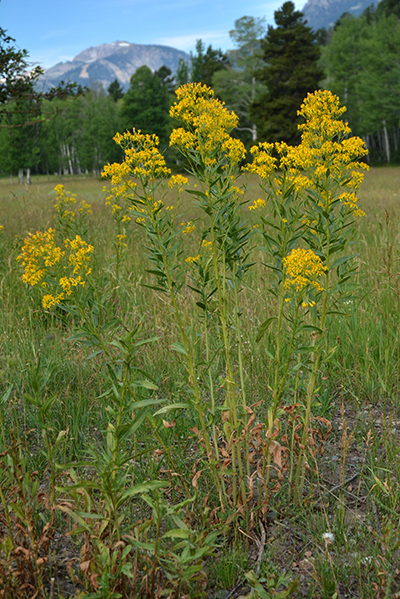
Butterweed Groundsel – Senecio serra – is common along road sides and in meadows right now. The 5-6″ elongated, serrated (like a saw) leaves help separate it from other large Groundsel species.

Butterweed Groundsel has shiny, even sized bracts, often black-tipped, surrounding each head of flowers.
Five-veined Little Sunflower/Helianthella –Helianthella quinquenervis – Not so little, this 3-4’ robust plant is closely related to One-flowered Sunflower (H. uniflora) seen throughout the valley these past few weeks. This species is larger, the flower heads are bent at right angles to the stalk—they appear to glare straight at you, and the lower leaves have 5 strong veins. It prefers more moist conditions than H. uniflora.
Western Coneflower – Rudbeckia occidentalis – This member of the Sunflower Family never looks quite in bloom (compare to Helilanthella above). We expect yellow “ray flowers” to whorl around the outside of each “head”. However, in this species, there are no flashy ray flowers, only a whorl of green bracts. There is a “cone” of tiny “disc” flowers which begin to bloom from the base and gradually, with time, spiral up to the tip. The bees know it is ready for pollination somehow and are often seen crawling around, dipping their mouth parts into the tiny maroon cups for nectar and collecting pollen.
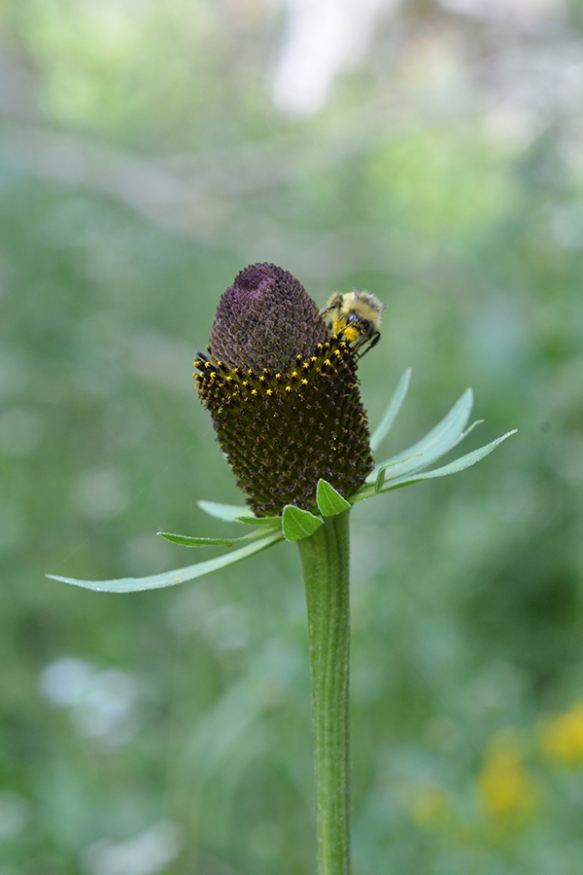
Western Coneflower – Rudbeckia occidentalis – Tiny disc flowers with yellow pollen attract bee pollinators. It flowers from bottom to top.
Mountain or Wild Hollyhock – Iliamna rivularis – Many people notice this pink plant popping up here or there along the park road or main highway, as well as in meadows or woodland edges.
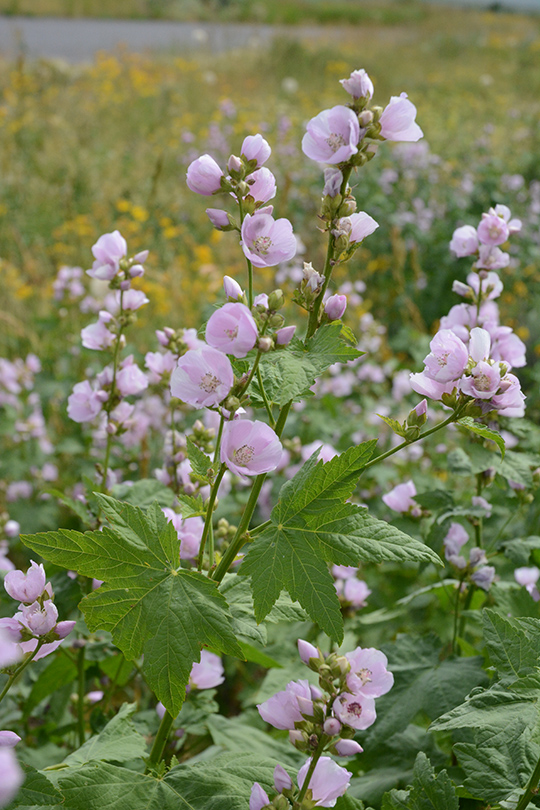
Mountain or Wild Hollyhock – Iliamna rivularis – pops up along highways, in the woods, and especially in areas after forest fires.
The stems are lined with many large 2-3” flowers. The stamens form a tube in the center with 5 roundish stigmas sticking out. The leaves are like maple leaves.
The hairy fruit will look like a somewhat compressed 1” tangerine which divides into several sections. This plant in the Mallow Family (Malvaceae) is related to garden hollyhock, marshmallow, okra, and cotton.
Mountain Bluebells – Mertensia ciliata – Colonies of 2-3’ bluebells inhabit wet seeps and meadows at high elevations.

Mountain Bluebell – Mertensia ciliata – colonizes wet meadows at high elevations, for instance above Ski Lake.
The 2-4” oval, bluish green leaves alternate up the stems which often arch over stream sides. The dangling tubular flowers start out pinkish and then turn blue when ready to attract bumblebee pollinators. The anthers have small pores at their tips. The frequency of buzzing bee-wing muscles shakes out the pollen onto the bee!

Mountain Bluebells – Mertensia ciliata – are buzz-pollinated. Bees vibrate their wings at a certain frequency, and pollen falls onto their bellies! Note the flowers go from pinkish purple to light blue, signaling to the bees when to visit.
Mountain Bluebells are self-compatible—they can receive their own pollen and make seeds, although the resultant off-spring often are not as strong – inbreeding depression.
Monkey Flower – Mimulus lewisii – These cheerful brilliant pink flowers with splashes of yellow on their lower petals ornament rivulets and seeps in the cool mountains. The leaves of Monkey Flower, which have three strong veins, are arranged opposite to each other along 2-3’ stems. They are pollinated by bumble- and mason bees.

Lewis’ Monkey Flower – Mimulus lewisii – graces seeps with its cheerful blooms. You can see the nectar guides attracting bumble- and mason bees into the center of the flower.
Some of you may have seen a very similar species in the Sierras – M. cardinalis – whose red flowers are pollinated by hummingbirds. In the laboratory, the species will interbreed; however, in nature where the ranges of the two species overlap they do not exchange genes: the pollinators are different. Therefore, the two species maintain their integrity and continue to evolve in their own way.

False Hellebore – Veratrum californicum/tenuipetalum – is having a “mast” year. This profuse stand is growing the west end of Phelps Lake.
False Hellebore – Veratrum californicum/tenuipetalum – This is a very poisonous plant in the Lily family (now split off into the Bunch-berry Family-Melanthiaceae) which grows in very damp soils. It has formed a very large, 6’-7′-tall colony along the west end of Phelps Lake this year. This is a display of “masting”—when a plant species produces many, many flowers and fruits synchronously in one year. The overabundance attracts many pollinators: flies during the day, moths at night, and the plentitude makes it difficult for all the seeds to be consumed.

The abundance of flowers of False Hellebore first satiates pollinators, and then once they are pollinated, hopefully flowers produce an abundance of seeds–too many to be eaten by hungry predators.
Research indicates that “masting” of False Hellebore is cued by cool July temperatures the previous year, a trigger which could be affected by warming of climate change. Observe the flowers near the top of the bountiful flower stalks: they are typically male and female, while the lower flowers are only male. See if you can find the difference.

Look at the flowers of False Hellebore closely. Apparently the upper flowers are “perfect” with both male and female parts. The lower flowers have only male parts. Hard to tell which this example is.
Information on dispersers and fate of the seeds of False Hellebores was not readily available in a web search. However, there is great information on the masting biology of these plants: http://www.amjbot.org/content/100/3/519.full
These are just a few of the fascinating flowers in bloom right now. A future posting will discuss some of the smaller species that are beginning to flourish. In any case, keep on hiking, observing, and enjoying the bounty of flowers we have this summer!
Frances Clark, Wilson, WY
July 23, 2015
P.S. As always, this blogger appreciates comments, corrections, additions to the information provided here.
9:50 p.m.



